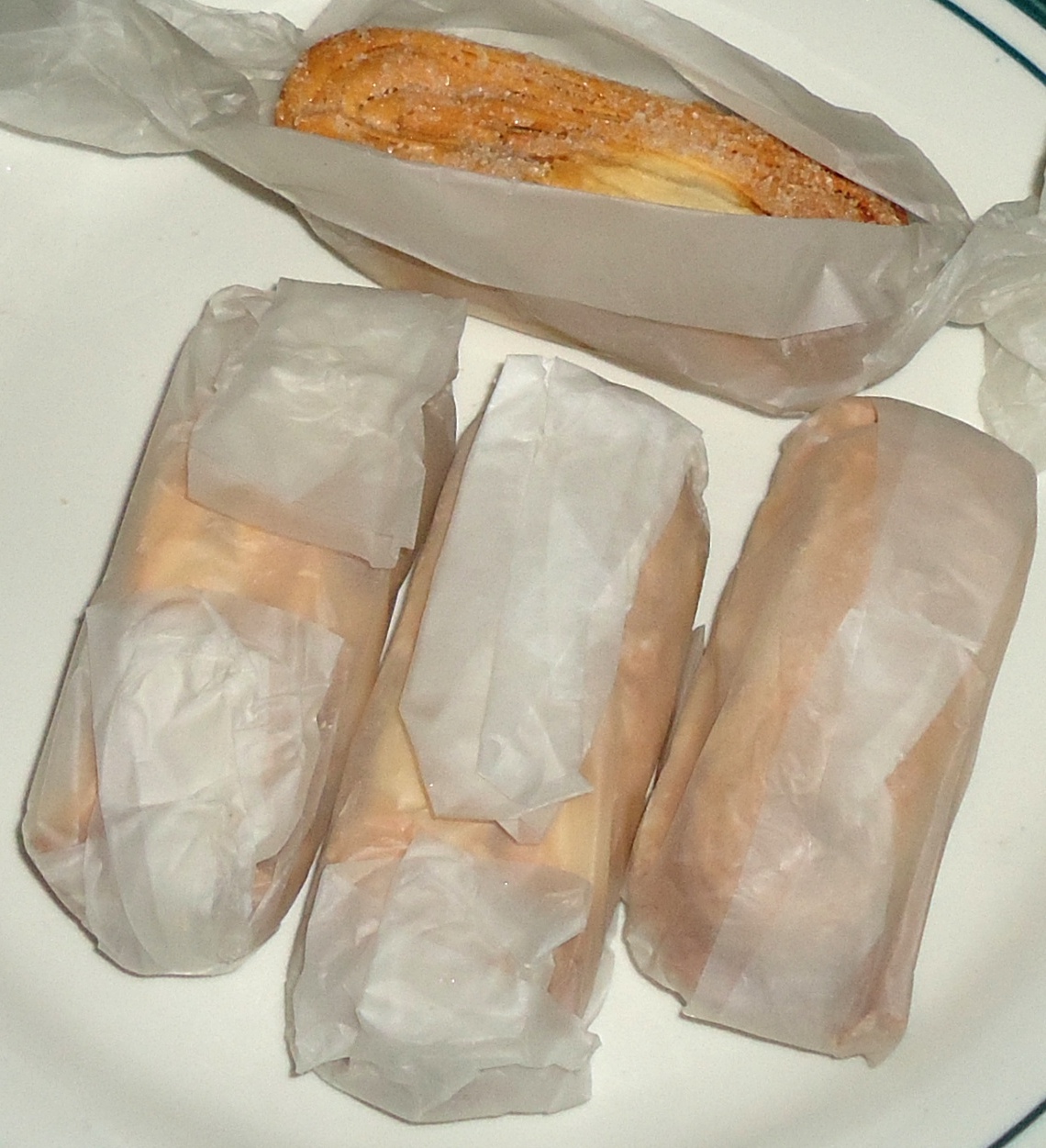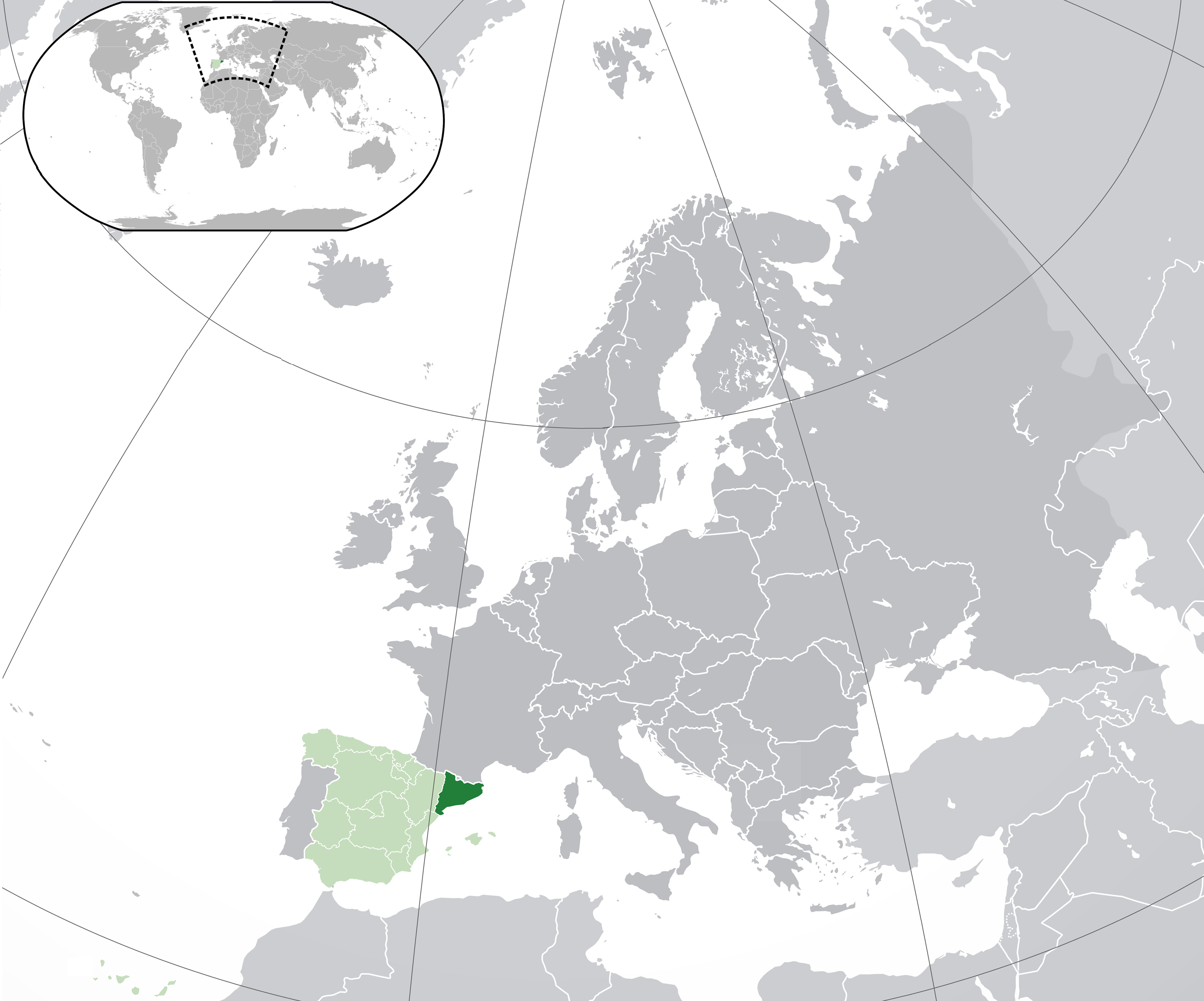|
Palmier
A palmier (, from French, short for ''feuille de palmier'' 'palm tree leaf'), pig's ear, palm heart, or elephant ear is a French pastry in a palm leaf shape or a butterfly shape, sometimes called ''palm leaves'', ''cœur de France'', ''French hearts'', ''shoe-soles'', or ''glasses'', that were invented in the beginning of the 20th century. Preparation Palmiers are made from puff pastry, a laminated dough similar to the dough used for croissants, but without yeast. The puff pastry is rolled out, coated with sugar, and then the two sides are rolled up together so that they meet in the middle, making a roll that is then cut into about slices and baked. Usually it is rolled in sugar before baking. Varieties The pastries are known as ''palmeras'' ("palm trees") in Spain, and they can be topped with coconut or chocolate; they are also available for purchase in a larger version. In the Puerto Rican version, they are topped with honey. In Mexico and other Latin American countri ... [...More Info...] [...Related Items...] OR: [Wikipedia] [Google] [Baidu] |
List Of Pastries
pastry, Pastries are small buns made using a stiff dough enriched with fat. Some dishes, such as pies, are made of a pastry casing that covers or completely contains a filling of various sweetness, sweet or Umami, savory ingredients. The six basic types of pastry dough (a food that combines flour and fat) are shortcrust pastry, filo pastry, choux pastry, flaky pastry, puff pastry and suet pastry. Doughs are either nonlaminated, when fat is cut or rubbed into the flour, or else laminated dough, laminated, when fat is repeatedly folded into the dough using a technique called lamination. An example of a nonlaminated pastry would be a pie or tart crust, and brioche. An example of a laminated pastry would be a croissant, danish pastry, danish, or puff pastry. Many pastries are prepared using shortening, a fat food product that is solid at room temperature, the composition of which lends to creating crumbly, shortcrust-style pastries and pastry crusts. Pastries were first created by the ... [...More Info...] [...Related Items...] OR: [Wikipedia] [Google] [Baidu] |
Otap (food)
''Otap'' (sometimes spelled ''utap'') is an oval-shaped puff pastry cookie from the Philippines, especially common in Cebu where it originated. It usually consists of a combination of flour, shortening, coconut, and sugar. It is similar to the French palmier cookies, but ''otap'' are oval-shaped and more tightly layered and thinner, making it crispier. In order to achieve the texture of the pastry, it must undergo an eleven-stage baking process. See also * Hojaldres * Apas (biscuit) * Palmier A palmier (, from French, short for ''feuille de palmier'' 'palm tree leaf'), pig's ear, palm heart, or elephant ear is a French pastry in a palm leaf shape or a butterfly shape, sometimes called ''palm leaves'', ''cœur de France'', ''French ... References External linksShort description of utap Culture of Cebu Puff pastry Coconut desserts Philippine pastries Visayan cuisine {{Philippines-dessert-stub ... [...More Info...] [...Related Items...] OR: [Wikipedia] [Google] [Baidu] |
Pastry Heart
A pastry heart is a regional dessert item found in the Western New York area, with Buffalo credited as the place where it was first created. The pastry heart is a heart-shaped flaky puff pastry Puff pastry, also known as , is a light, flaky pastry, its base dough () composed of wheat flour and water. Butter or other solid fat () is then layered into the dough. The dough is repeatedly rolled and folded, rested, re-rolled and folded, encas ..., similar to a palmier, that is usually topped with a white sugar icing that has a hard shell but is soft on the inside. See also * Buffalo wings * Garbage Plate * Grape pie * Loganberry drink * Texas hots References Culture of Buffalo, New York Cuisine of New York (state) Pastries Cuisine of the Mid-Atlantic states {{US-dessert-stub ... [...More Info...] [...Related Items...] OR: [Wikipedia] [Google] [Baidu] |
Puff Pastry
Puff pastry, also known as , is a light, flaky pastry, its base dough () composed of wheat flour and water. Butter or other solid fat () is then layered into the dough. The dough is repeatedly rolled and folded, rested, re-rolled and folded, encasing solid butter between each resulting layer. This produces a laminated dough. During baking, gaps form between the layers left by the fat melting; the pastry is leavened by steam from the water content of the fat as it expands, puffing the separate layers. The pastry layers crisp as the heated fat is in contact with its surfaces. History While modern puff pastry was developed in France in the 17th century, related laminated and air-leavened pastry has a long history. In Spain, likely built upon Arab or Moorish culinary traditions, the first known recipe for pastry using butter or lard following the Arab technique of making each layer separately, appears in the Spanish recipe book ('book on the art of cooking') by Domingo Hernández d ... [...More Info...] [...Related Items...] OR: [Wikipedia] [Google] [Baidu] |
Pastry
Pastry refers to a variety of Dough, doughs (often enriched with fat or eggs), as well as the sweet and savoury Baking, baked goods made from them. The dough may be accordingly called pastry dough for clarity. Sweetened pastries are often described as ''Flour confections, baker's confectionery''. Common pastry dishes include pies, tarts, quiches, croissants, and Turnover (food), turnovers. The French word pâtisserie is also used in English (with or without the accent) for many of the same foods, as well as the set of techniques used to make them. Originally, the French word referred to anything, such as a meat pie, made in dough (''paste'', later ''pâte'') and not typically a luxurious or sweet product. This meaning still persisted in the nineteenth century, though by then the term more often referred to the sweet and often ornate confections implied today. Definitions The precise definition of the term pastry varies based on location and culture. Common doughs used to make ... [...More Info...] [...Related Items...] OR: [Wikipedia] [Google] [Baidu] |
Portuguese Desserts
Portuguese may refer to: * anything of, from, or related to the country and nation of Portugal ** Portuguese cuisine, traditional foods ** Portuguese language, a Romance language *** Portuguese dialects, variants of the Portuguese language ** Portuguese man o' war, a dangerous marine animal ** Portuguese people, an ethnic group See also * * ''Sonnets from the Portuguese'' * "A Portuguesa", the national anthem of Portugal * Lusofonia * Lusitania Lusitania (; ) was an ancient Iberian Roman province encompassing most of modern-day Portugal (south of the Douro River) and a large portion of western Spain (the present Extremadura and Province of Salamanca). Romans named the region after th ... * {{disambiguation Language and nationality disambiguation pages ... [...More Info...] [...Related Items...] OR: [Wikipedia] [Google] [Baidu] |
Catalan Cuisine
Catalan cuisine is the cooking traditions and practices from Catalonia. It may also refer to the shared cuisine of Northern Catalonia and Andorra, the second of which has a similar cuisine to that of the neighbouring Alt Urgell and Cerdanya ''comarca, comarques'' and which is often referred to as "Catalan mountain cuisine". It is considered a part of western Mediterranean cuisine. History There are several Catalan language cookbooks from the Middle Ages that are known to modern scholars. The ''Llibre del Coch'' (1520) was one of the most influential cookbooks of Spanish Renaissance, Renaissance Spain. It includes several sauce recipes made with ingredients such as ginger, Mace (spice), mace powder ('), cinnamon, saffron, cloves ('), wine and honey. ''Salsa de pagó'' took its name from the peacock () that it was intended to be served with, but could accompany any type of poultry, and was part of the medieval Christmas dinner#Spain, Christmas meal. ' (or ' as it's called in the ... [...More Info...] [...Related Items...] OR: [Wikipedia] [Google] [Baidu] |
Argentine Cuisine
Argentine cuisine is described as a blending of cultures, from the Indigenous peoples of Argentina who focused on ingredients such as humita, potatoes, cassava, peppers, tomatoes, Poroto, beans, and yerba mate, to Mediterranean cuisine, Mediterranean influences brought by the Spanish during the colonial period. This was complemented by the significant influx of Italian Argentine, Italian and Spanish Argentine, Spanish immigrants to Argentina during the 19th and 20th centuries, who incorporated plenty of their food customs and dishes such as Argentine pizza, pizzas, pasta and Spanish omelette, Spanish tortillas. Beef is a main part of the Argentine diet due to its vast production in the country's plains. In fact, Argentine annual consumption of beef has averaged per capita, approaching per capita during the 19th century; consumption averaged in 2007. Beyond ''asado'' (the Argentine barbecue), no other dish more genuinely matches the national identity. Nevertheless, the coun ... [...More Info...] [...Related Items...] OR: [Wikipedia] [Google] [Baidu] |
French Pastries
French may refer to: * Something of, from, or related to France ** French language, which originated in France ** French people, a nation and ethnic group ** French cuisine, cooking traditions and practices Arts and media * The French (band), a British rock band * "French" (episode), a live-action episode of ''The Super Mario Bros. Super Show!'' * ''Française'' (film), a 2008 film * French Stewart (born 1964), American actor Other uses * French (surname), a surname (including a list of people with the name) * French (tunic), a type of military jacket or tunic * French's, an American brand of mustard condiment * French (catheter scale), a unit of measurement * French Defence, a chess opening * French kiss, a type of kiss See also * France (other) * Franch, a surname * French Revolution (other) * French River (other), several rivers and other places * Frenching (other) Frenching may refer to: * Frenching (automobile), recessing or moul ... [...More Info...] [...Related Items...] OR: [Wikipedia] [Google] [Baidu] |
Cinnamon
Cinnamon is a spice obtained from the inner bark of several tree species from the genus ''Cinnamomum''. Cinnamon is used mainly as an aromatic condiment and flavouring additive in a wide variety of cuisines, sweet and savoury dishes, biscuits, breakfast cereals, Snack, snack foods, bagels, teas, hot chocolate and traditional foods. The aroma and flavour of cinnamon derive from its essential oil and principal component, cinnamaldehyde, as well as numerous other constituents, including eugenol. Cinnamon is the name for several species of trees and the commercial spice products that some of them produce. All are members of the genus ''Cinnamomum'' in the family Lauraceae. Only a few ''Cinnamomum'' species are grown commercially for spice. ''Cinnamomum verum'' (alternatively ''C. zeylanicum''), known as "Ceylon cinnamon" after its origins in Sri Lanka (formerly Ceylon), is considered to be "true cinnamon", but most cinnamon in international commerce is derived from four other speci ... [...More Info...] [...Related Items...] OR: [Wikipedia] [Google] [Baidu] |
Buffalo, New York
Buffalo is a Administrative divisions of New York (state), city in the U.S. state of New York (state), New York and county seat of Erie County, New York, Erie County. It lies in Western New York at the eastern end of Lake Erie, at the head of the Niagara River on the Canada–United States border, Canadian border. With a population of 278,349 according to the 2020 census, Buffalo is the List of municipalities in New York, second-most populous city in New York State after New York City, and the List of United States cities by population, 82nd-most populous city in the U.S. Buffalo is the primary city of the Buffalo–Niagara Falls metropolitan area, which had an estimated population of 1.1 million in 2020, making it the List of metropolitan statistical areas, 49th-largest metro area in the U.S. Before the 17th century, the region was inhabited by nomadic Paleo-Indians who were succeeded by the Neutral Confederacy, Neutral, Erie people, Erie, and Iroquois nations. In the early 1 ... [...More Info...] [...Related Items...] OR: [Wikipedia] [Google] [Baidu] |




